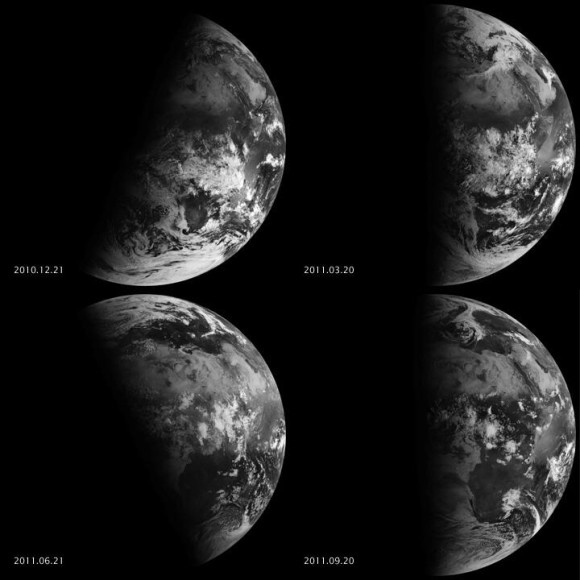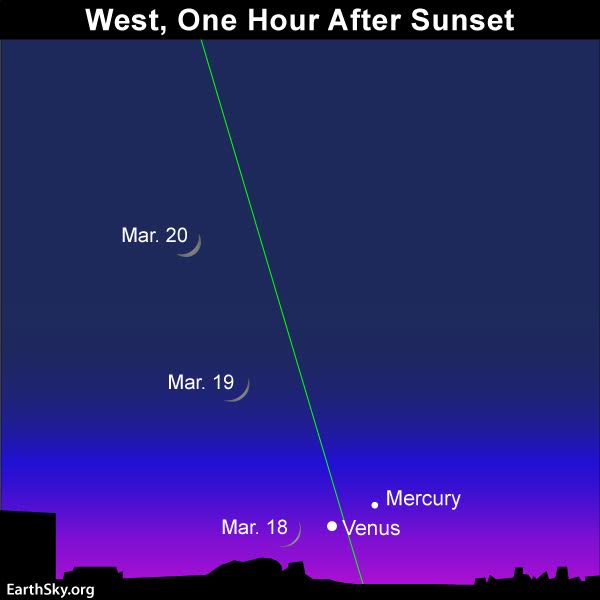March equinox: All you need to know
By Deborah Byrd in Astronomy Essentials | March 18, 2018The 2018 equinox comes March 20 at 16:15 UTC. It’s an event that happens on our sky’s dome – and a seasonal marker in Earth’s orbit around the sun.

Image from 2011, via Geosync.
Although there’s nothing official about it, it’s traditional to say the March or vernal equinox signals the beginning of spring in the Northern Hemisphere and autumn in the Southern Hemisphere. This equinox does provide a hallmark for the sun’s motion in our sky, marking the passage of the sun across the celestial equator, going from south to north. The March 2018 equinox happens on March 20 at 16:15 UTC, which is 11:15 a.m. Central Daylight Time for us in the central U.S.; translate to your time zone.
In the Northern Hemisphere now, we’re enjoying earlier sunrises, later sunsets, softer winds, sprouting plants. Meanwhile, you’ll find the opposite season – later sunrises, earlier sunset, chillier winds, dry and falling leaves – south of the equator.
For all of us on this March 2018 equinox, the moon will be in a waxing crescent phase, in your western sky after sunset, with its illuminated portion pointing downward toward the planets Venus and Mercury.
Watch for them!

On March 18 to 20, look west after sunset to see the moon near the 2 innermost worlds of the solar system, Mercury and Venus. Read more.
The equinoxes and solstices are caused by Earth’s tilt on its axis and ceaseless motion in orbit. You can think of an equinox as happening on the imaginary dome of our sky.
The Earth-centered view is that the celestial equator is a great circle dividing Earth’s sky into Northern and Southern hemispheres. The celestial equator wraps the sky directly above Earth’s equator. At the equinox, the sun crosses the celestial equator, to enter the sky’s Northern Hemisphere.
The Earth-in-space view is that, because Earth doesn’t orbit upright, but is instead tilted on its axis by 23-and-a-half degrees, Earth’s Northern and Southern hemispheres trade places in receiving the sun’s light and warmth most directly, as Earth orbits the sun. We have an equinox twice a year – spring and fall – when the tilt of the Earth’s axis and Earth’s orbit around the sun combine in such a way that the axis is inclined neither away from nor toward the sun.

Cherry blossoms opening in Japan, via EarthSky community member Beverly Fish.
At the equinox, Earth’s two hemispheres are receiving the sun’s rays equally. Night and day are often said to be equal in length. In fact, the word equinox comes from the Latin aequus (equal) and nox (night). For our ancestors, whose timekeeping was less precise than ours, they likely did seem equal. But we today know it’s not exactly so. Read more: Are day and night equal at the equinox?

The day arc of the sun, every hour, during the equinox as seen on the celestial dome, from the pole. Image via Tau’olunga at Wikimedia Commons.
Here’s another equinox truism. You might hear that the sun rises due east and sets due west at the equinox. True? In fact, this is true. And that’s true no matter where you live on Earth. At the equinoxes, the sun appears overhead at noon as seen from Earth’s equator, as the illustration above shows. This illustration shows the sun’s location on the celestial equator, every hour, on the day of the equinox.
No matter where you are on Earth, you have a due east and due west point on your horizon. That point marks the intersection of your horizon with the celestial equator – the imaginary line above the true equator of the Earth.
That’s why the sun rises due east and sets due west for all of us. The sun is on the celestial equator, and the celestial equator intersects all of our horizons at points due east and due west. Read more: Sun rises due east and sets due west
Since Earth never stops moving around the sun, the position of the sunrise and sunset – and the days of approximately equal sunlight and night – will change quickly.
The video below was the Astronomy Picture of the Day for March 19, 2014. APOD explained:
At an equinox, the Earth’s terminator – the dividing line between day and night – becomes vertical and connects the north and south poles. The time-lapse video [below] demonstrates this by displaying an entire year on planet Earth in 12 seconds. From geosynchronous orbit, the Meteosat satellite recorded these infrared images of the Earth every day at the same local time. The video started at the September 2010 equinox with the terminator line being vertical. As the Earth revolved around the sun, the terminator was seen to tilt in a way that provides less daily sunlight to the northern hemisphere, causing winter in the north. As the year progressed, the March 2011 equinox arrived halfway through the video, followed by the terminator tilting the other way, causing winter in the southern hemisphere — and summer in the north. The captured year ends again with the September equinox, concluding another of billions of trips the Earth has taken — and will take — around the sun.
https://youtu.be/LUW51lvIFjg
Where can you look to see signs of the equinox in nature? Everywhere! Forget about the weather for a moment, and think only about the daylight. In terms of daylight, the knowledge that spring is here – and summer is coming – permeates the northern half of Earth’s globe.
Notice the arc of the sun across the sky each day. You’ll find it’s shifting toward the north. Responding to the change in daylight, birds and butterflies are migrating back northward, too, along with the path of the sun.
The longer days do bring with them warmer weather. People are leaving their winter coats at home. Trees are budding, and plants are beginning a new cycle of growth. In many places, spring flowers are beginning to bloom.
Meanwhile, in the Southern Hemisphere, the days are getting shorter and nights longer. A chill is in the air. Fall is here, and winter is coming!

The equinox is an event that takes place in Earth’s orbit around the sun.
Bottom line: The 2018 equinox comes March 20 at 16:15 UTC; translate to your time zone. It’s an event that happens on our sky’s dome – and a seasonal marker in Earth’s orbit around the sun!
A Chinese perspective on the spring equinox
Deborah Byrd
Thanks to: http://earthsky.org






 Sat Mar 23, 2024 11:33 pm by globalturbo
Sat Mar 23, 2024 11:33 pm by globalturbo

